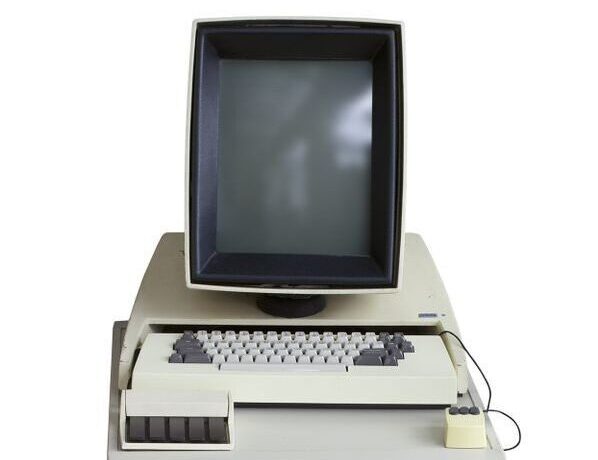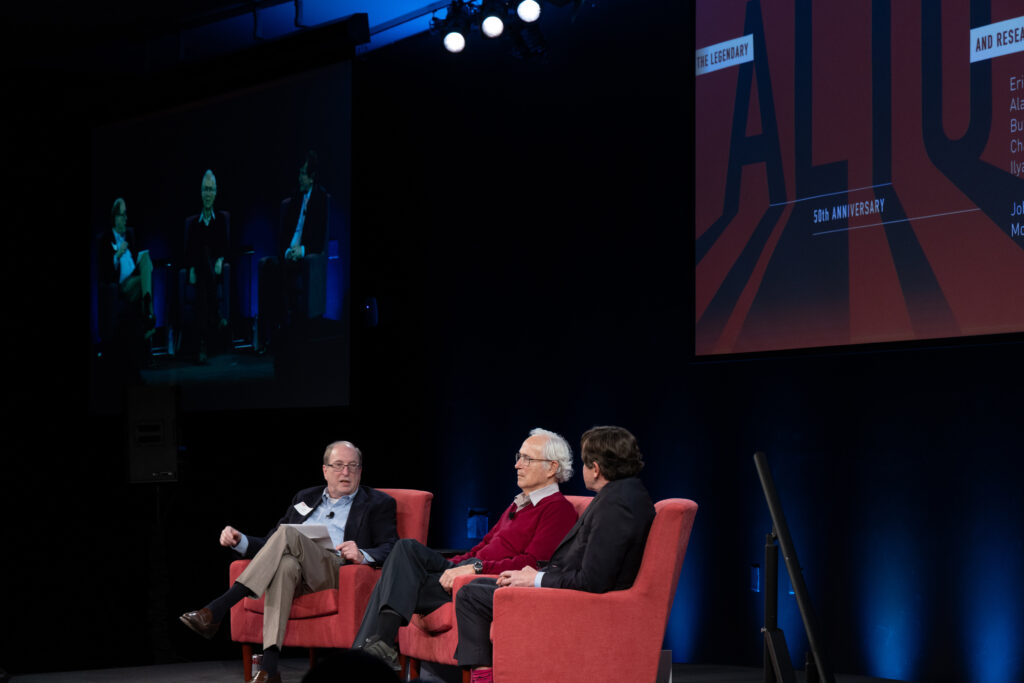

An Alto computer in CHM's collection.
In 1973, the innovators at Xerox’s Palo Alto Research Center (PARC) had a time machine. The Alto computer transported computing 15 years into the future with its groundbreaking features and functions. It influenced Steve Jobs and Bill Gates and a generation of researchers. A half century later, how we live with computing is still shaped by the Alto.
On the 50th anniversary of the Alto, many of its creators and some of today’s leading inventors gathered at CHM to share the Alto’s legacy and discuss what we can expect for the future of computing research—centered today on artificial intelligence (AI).
CHM Trustee John Shoch, who worked at PARC as a graduate student, moderated a discussion with two of Alto’s designers, Butler Lampson and Charles Simonyi. Alan Kay participated via video.

John Shoch, Butler Lampson, and Charles Simonyi
In the late 1960s, when mainframe computing was evolving, interactive computing was being done with time-sharing because it was economical. But, Lampson said, that wasn’t how anyone wanted to do it. Everyone wanted an efficient, working personal computer like the Alto.
Corporate behemoth Xerox decided to get into the computer business, and in 1970, Bob Taylor, an ARPA founder (Advanced Research Projects Agency), was hired to set up PARC, with a mandate to create the office of the future. Alan Kay was one of his first hires, and he admired how Taylor created a culture to facilitate collaboration among “lone wolves.”
Alan Kay describes the culture of PARC.
Lampson explained that the prevailing way of doing computing research at the time was on a DEC PDP-10. But DEC was a competitor of SDS, which Xerox had just bought, so they didn’t want to ask for the machines for the lab. Instead, they decided to build one. The result was the MAX computer, a precursor of Alto. Simonyi described working with Chuck Thacker on the machine.
Charles Simonyi talks about building the MAX computer.
Lampson believes that advances in computing, including today’s deep learning, are limited only by hardware, specifically memory. Perhaps equally important are far-seeing visions. Kay explained how PARC researchers homed in on ideas from the larger ARPA community: the destiny of computers was to become personal intellectual amplifiers spread over the earth and pervasively networked to everyone. The Alto was their response to that vision.
Butler Lampson describes Alto’s popularity.
The Alto was a perfect machine, says Simonyi, "So generous and at the same time so simple.” The keyboard read bits, the mouse gave bits rather than coordinates, the output interfaced with a 32x70 display with bits. But there was only a megabit of memory, under 128K. The panelists remembered that your text would disappear from the bottom up if the machine needed to pull memory to execute on formatting or printing commands. Alto software had to be developed as completely separate applications, only connected through the file system. There were several efforts to get around this, but all failed except Smalltalk.
In conclusion, Kay noted that when innovative research produces powerful tools, it’s important that training and education are an integral part of the system to ensure the tools are "used for good.” He believes that today’s computing power should be directed by high ideals like those pursued at PARC.
The second panel focused on artificial intelligence, arguably the most revolutionary sector in today's computing landscape. CHM Trustee Diane Souvaine led the discussion with two computer scientists from pioneering research labs: Ilya Sutskever, cofounder and chief scientist of Open AI, and Microsoft Chief Scientific Officer Eric Horvitz.
Both Sutskever and Horvitz aim to foster creative, collaborative labs focused on big ideas. Sutskever notes that all of computing has just one goal right now: To build artificial intelligence that actually loves humanity. Horvitz thinks computing systems should be reasoning about how to complement humans in a deep way, to understand gaps in thinking, synthesize information, and perform other functions that can lead to breakthroughs we can’t even imagine.
Ilya Sutskever describes what AI might accomplish.
The panelists were frank that AI in various forms and expanding beyond research programs will be extremely disruptive to humanity. It will affect jobs and the economy, education, and how we spend our time. It will also, Horvitz notes, impact our sense of our uniqueness and identity as human beings. With guidance and ongoing deliberation across civil society and government, he believes things can go well. Sutskever also hopes for positive outcomes but cautions that AI is going to be incredibly powerful, and with such power comes significant risks.
Eric Horvitz explores the perils of AI.
Sutskever says that many layers of guardrails can be placed by those developing AI technology, for example in refusing unacceptable requests. But we also need wise, well-chosen societal rules and collective choices that will lead to a better environment and outcome for everyone.
Without a doubt, we will see creative and unexpected solutions as people use AI, and also new problems caused by AI that we haven’t seen before. These things, says Horvitz, will happen at the same time. Adds Sutskever, “It will be not boring.”
CHM would like to thank Arista Networks for their generous support of “The Legendary Alto and Research at the Edge.”
The Legendary Alto and Research at the Edge | CHM Live, April 26, 2023
David C. Brock, “50 Years Later, We’re Still Living in the Xerox Alto’s World,” https://spectrum.ieee.org/xerox-alto
The Alto in CHM’s flagship exhibition, Revolution: The First 2000 Years of Computing, https://www.computerhistory.org/revolution/input-output/14/347
A selection of video recordings featuring an Alto computer restored by CHM, https://youtube.com/playlist?list=PLQsxaNhYv8dbSX7IyztvLjML_lgB1C_Bb
A 1986 lecture by Alan Kay, “The Dynabook—Past, Present, and Future,” https://www.youtube.com/watch?v=GMDphyKrAE8&list=PLQsxaNhYv8dbIuONzZcrM0IM7sTPQFqgr&index=8
A 1986 lecture by Butler Lampson, “Personal Distributed Computing – The Alto and Ethernet Software,” https://www.youtube.com/watch?v=h33A-KWJKDQ&list=PLQsxaNhYv8dbIuONzZcrM0IM7sTPQFqgr&index=9
A 1986 lecture by Chuck Thacker, “Personal Distributed Computing – The Alto and Ethernet Hardware,” https://www.youtube.com/watch?v=A9n2J24Jg2Y&list=PLQsxaNhYv8dbIuONzZcrM0IM7sTPQFqgr&index=10
Access to Xerox PARC's file system archive is coming soon! Sign up to receive notification.